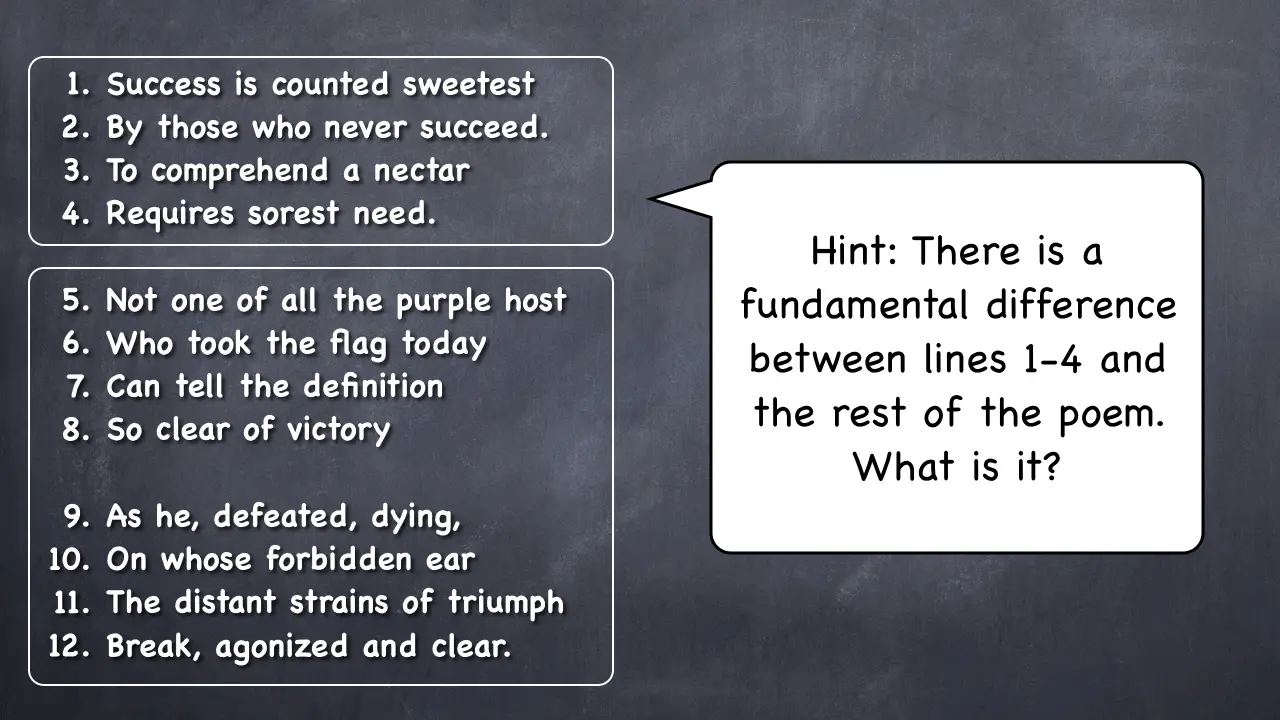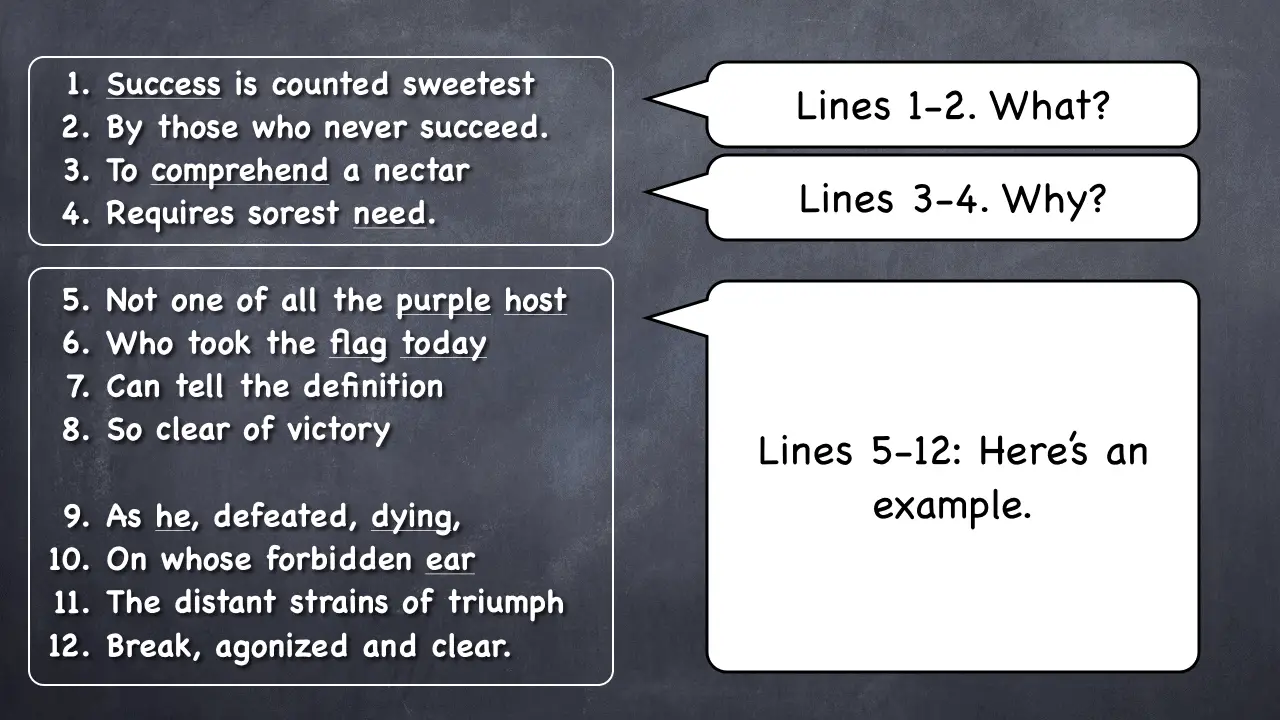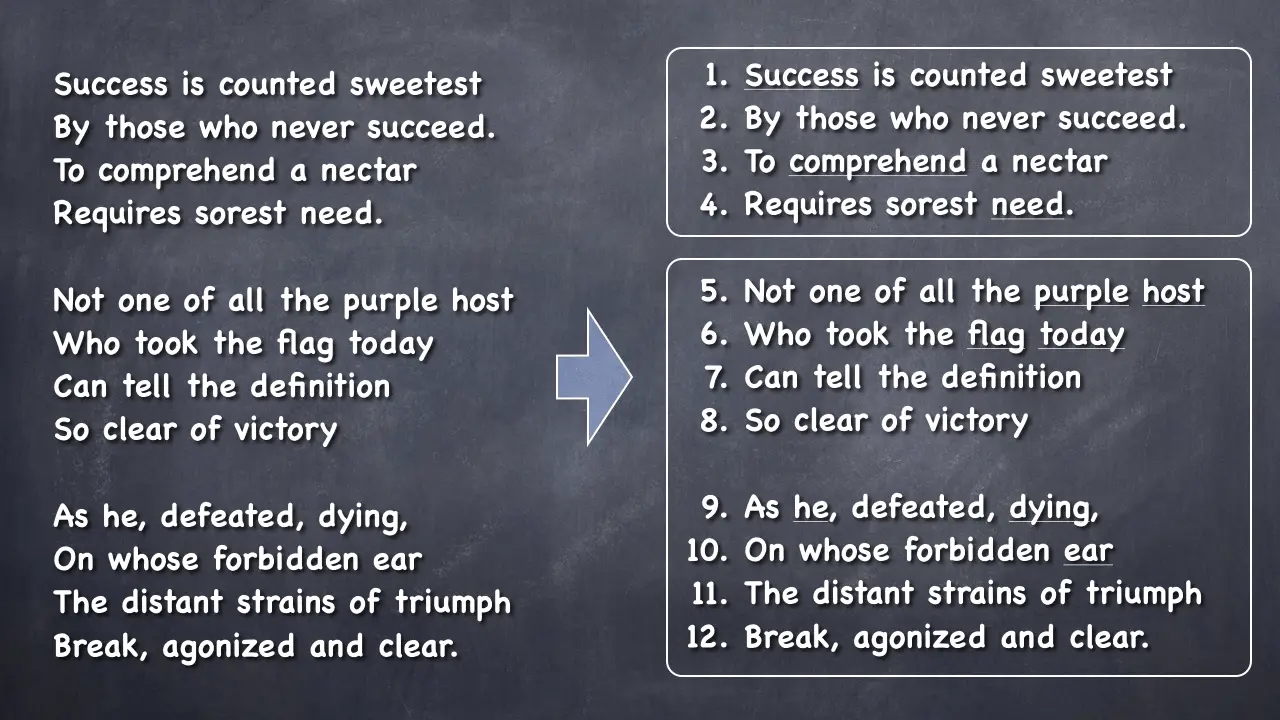Emily Dickinson’s “Success Is Counted Sweetest” is a lyric poem in which the author argues that those who lack success appreciate it more than those who have it. And she uses an example of a dying soldier to illustrate her argument.
In her short but powerful poem, Emily Dickinson manages to make a strong statement and then support it by a dramatic example.
In this analysis, I’ll show you exactly how to make complete sense out of this poem. And if you’re trying to write an essay on it, you’ll get a few excellent ideas.
How to Read and Understand a Poem
In order to read and comprehend a poem (or any work of literature), it is necessary to ask these two questions repeatedly:
- What are the parts of this poem?
- What is the relationship between the parts?
That’s essentially the meaning of “analysis” – to break down into parts and understand the relationship between them.
In our analysis of Emily Dickinson’s poem, we’ll do exactly that.
Success Is Counted Sweetest by Emily Dickinson
Success is counted sweetest By those who never succeed. To comprehend a nectar Requires sorest need. Not one of all the purple host Who took the flag today Can tell the definition So clear of victory As he, defeated, dying, On whose forbidden ear The distant strains of triumph Break, agonized and clear!
Let’s Get Vocabulary Out of the Way
Let’s make sure we understand every word in the poem. It is hard to understand the meaning of a poem if you don’t know some of the words.
“Nectar” is sweet, sugary fluid secreted by plants. Bees collect it along with pollen to make honey. So, it’s something sweet and desirable.
“Sorest” means the most painful, or the most extremely painful. If you look up “sore,” you’ll find that its old meaning as an adverb is “extremely or severely.”
“Host” here means “army.” We’re not talking about hosting a party or thinking a host of a show or anything like that. It’s just “army.”
“Strains of triumph” refer to sounds of victory or celebration. You can think of the sound of military brass that accompanies an advancing, victorious army.
Let’s Identify the Main Parts of the Poem
So, what are the parts in this poem? Can we find a distinction between some of the sections?
Let me give you a hint.

As you can see in the diagram, it looks like the poem does have two sections that are different from one another in some fundamental way.
What is that difference? Let’s take a look.
First Section (Lines 1-4)
If we look closely at the first section, here are the terms that dominate it:
- Success
- Comprehend
- Never
- Need
What do these words share? They all have different meanings, but they have something in common.
Here’s the answer. They are all very abstract.
I mean, can you picture “success?” Not really. You can draw a symbol of success, such as a trophy, for example. But the word “success” is abstract, not concrete.
The same with the rest of the terms. “Comprehend,” “never,” “need” are all abstract. They cannot be easily pictured or imagined.
The only word in lines 1-4 that refers to a concrete thing is the word “nectar.” But the author uses this word in an abstract way. She means it to be synonymous with success.
So, it’s a very abstract section.
Second Section (Lines 5-12)
Now, let’s take a look at the terms that dominate in this part of the poem:
- Purple host
- Flag
- Today
- He
- Dying
- Ear
- Strains of triumph (military brass)
As you’ve probably guessed by now, these terms are not abstract, unlike those in the first section. These words are concrete.
Most of them are pictures:
“Purple host” is an army of men dressed in purple uniforms.
A “flag” is a concrete image.
“He” refers to a concrete man.
You may say, what about the word “today?” You can’t picture “today.”
That’s true. But compare “today” with “never” in the previous section. Do you hear the difference?
While “never” refers to infinity or eternity, “today” refers to a very concrete period of time.
In other words, we must conclude that the first section is more abstract while the second is more concrete.
What Is Our Conclusion From This?
In this poem, the first four lines are the Argument.
And the last eight lines are the support of the argument – namely, an example.
Note that the first section contains two sentences. The first one answers the question “What?’ The second answers the question “Why?”
Lines 5-12 are one long sentence containing one piece of evidence – an illustration of the argument stated in the first four lines.

We can imagine having a conversation with Emily Dickinson:
– What are you saying, Ms. Dickinson?
– I am saying that success is counted sweetest by those who never succeed.
– Why do you believe that?
– Because to comprehend a nectar requires sorest need.
– That’s interesting. Could you give me an example?
– Sure. Not one soldier of the victorious army appreciates the victory the way this dying soldier does who can not enjoy it.
Summary and Interpretation
And now, the meaning has become clear. By trying to identify the different parts of the poem, we were able to arrive at the meaning.
Now, instead of having 12 lines of poetry, we have two distinct sections that allow us to “see” the meaning. Once we’ve seen it, we’ll never forget it:

Now we can clearly see Emily Dickinson’s argument:
“Only those who lack success can truly appreciate it.”
And we know that she gives us an amazing, colorful, and emotionally charged image of a dying soldier who values victory more than any soldier of the victorious army.
Essay Ideas
If you have to write an essay on this poem, here are some ideas you can use.
You can argue that Emily Dickinson makes a general statement and then supports it, much like in an expository essay. And this is true – that’s exactly what she does.
You can also write about Emily Dickinson’s use of language to deliver her message. She uses abstract language in the beginning and concrete language in the second part.
You can also combine these essay ideas into one longer essay, depending on how many words you need.
Hope this was helpful!
